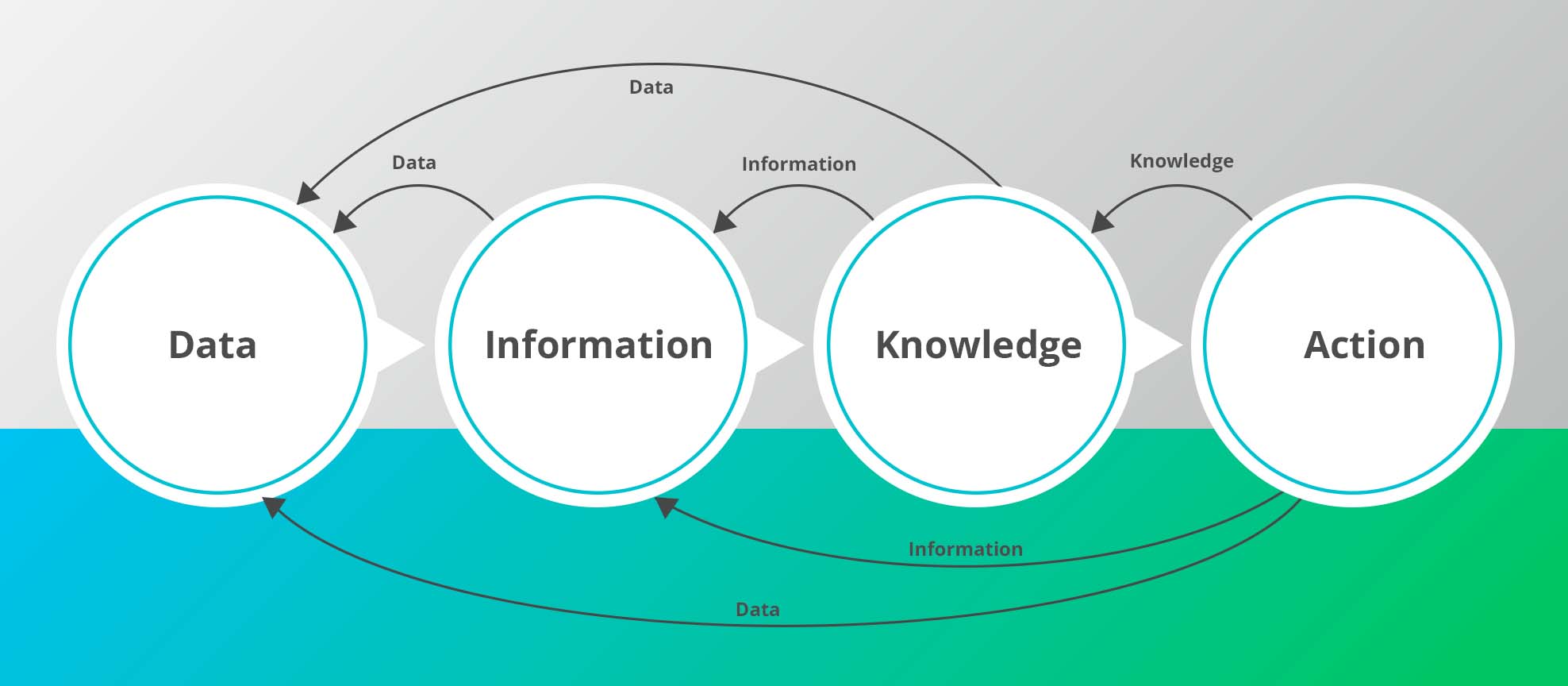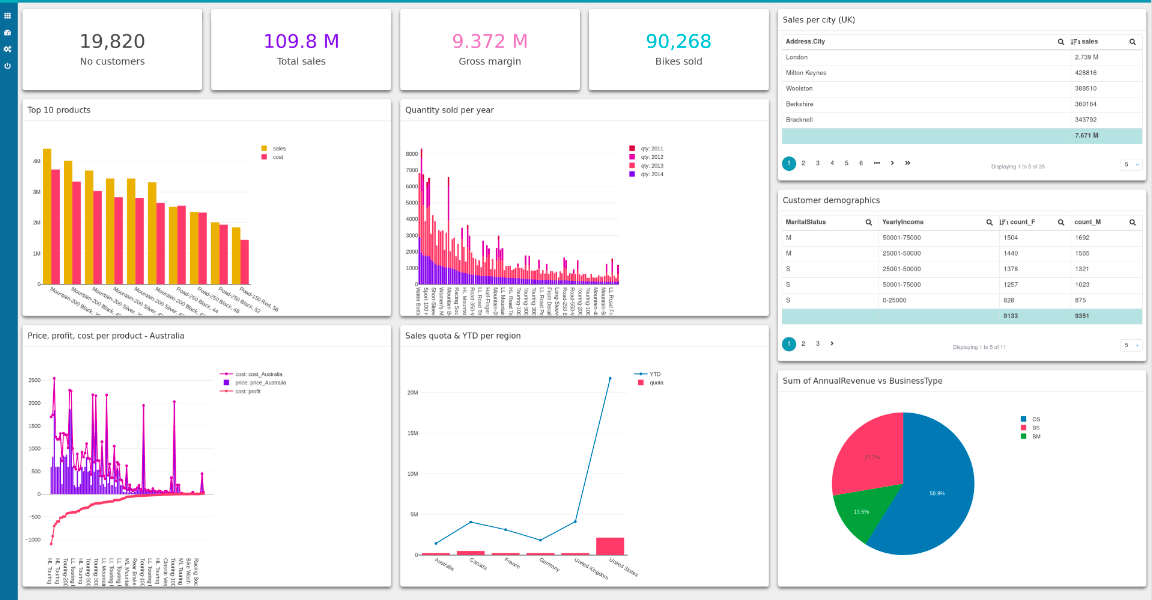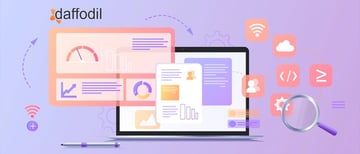.jpg?width=700&name=blog%20banner%20(4).jpg)
An organization’s data is its most essential resource and its day-to-day operations produce data in abundance. But to derive actionable insights that help make data-driven decisions, it is important to remove inefficiencies in the way the data is consumed and visualized. Business Intelligence, or BI, is a group of services that empower businesses to leverage their data for driving enterprise excellence.
Business Intelligence services are effective in not just representing data comprehensively, but also to convey the meaning behind that data. Contemporary BI tools are highly versatile in the data-driven solutions that they provide and allow for multi-dimensional reporting of how data pipelines exist within enterprises.
But business intelligence goes beyond just picking up data randomly, data democratization and arranging it aesthetically. In this article, we attempt to decipher exactly what BI is and how it works. As we move further, we will explore several of its aspects, from its features and benefits to some examples where it sees its implementation.
|
Table Of Contents |
What Is Business Intelligence?
| Business Intelligence refers to the technological infrastructure that enables organizations to transform both current and historic business data into easily digestible reports and other representations. |
BI instruments allow for exhaustive and detailed data access that leads to analytical insights in the form of dashboards, catalogs, spreadsheets, charts, graphs, and summaries. Data is extracted and processed into insightful information. This information, because of being easy to digest and accessible, becomes a knowledge bank, through which action to drive decisions can be taken.

There are several variations to BI across fields of study and industries, based on the delivery method for the information.
Examples Of Business Intelligence
Some examples of data processing that function along the lines of Business Intelligence include:
1)Data Mining:
Pattern recognition from massive datasets for the extraction of valuable insights that can be used to drive a business is known as data mining. It is a business intelligence method that has been in use for several years now. Based on statistical data points, you can correlate the driving force behind one data point to another data point to develop data clusters to accumulate more weighty insights.
2)Performance Metrics:
This Business Intelligence methodology involves the assessment of real-time decisions and associated adjustments to thoroughly gauge the performance of employees, products, and the enterprise as a whole. It also goes beyond this scope by comparing the performances of multiple enterprises functioning within a particular domain to draw market-wide performance modalities.
3)Statistical Analysis:
In statistical analysis, a large set of data related to business is observed at a glance, a sample set is generated and trends are identified. The sample-set is a smaller collection of data points that represents enough data to draw conclusions that could provide insights applicable to the enterprise without disrupting its end-to-end workflow in impactful ways.
Customer Success Story: Developing a mobile solution for one of America’s fast-growing wealth management platforms
4)ETL:
When data volumes become difficult to maintain and sift through, Extract, Transform, and Load, ETL strategies can be leveraged. The voluminous data is divided up into more manageable data models and data mapping is done to establish correlations between various data models. Duplicates are removed so that the resultant data mart or data bank is standardized so that there is only minimal ambiguity in the insights drawn from the data.
5)Data Distillation:
Data distillation goes one step beyond data collection or discovery by refining the data accumulated from various sources. With methods such as in-memory data manipulation, querying as well as conventional reporting, customized views of the aggregated data are made available for business analysts. The data quality is simultaneously maintained based on a prepared repository of rules and a comprehensive library of functions.
Who Needs Business Intelligence?
The Business Intelligence tool that you choose must fulfill the basic requirement of collecting data from departmental silos and providing enterprise-wide insights of value. From C-suite executives to department heads to data scientists, everyone is involved in the accumulation of valuable insights to drive business decisions. The types of users who leverage BI tools the most include:
1)Data Operators
Employees whose primary role in the company is satisfied by data are either known as data operators, business analysts, or knowledge workers. Their entire contribution to the enterprise's bottom line depends on the quality and legitimacy of data accumulated by them. They exist at the top of the information consumption pyramid of the firm. They make decisions about process optimization based on the business intelligence they manage to accumulate.
2)Business Clientele
For a business to maintain a regular cycle of repeat business with a dependable clientele, there needs to be open and clear communication about several bits of information. A regular customer of the company may need data points relating to ordering patterns, stock levels, Service Level Agreements (SLA), and payment avenues. They can acquire and access all this data through an efficient Business Intelligence platform or system.
3)C-Suite
The board of directors of a company, top management, or the C-suite, i.e., CEOs/CTOs/COOs take care of the entire workflow of the company's change processes. Be it fundamental changes that can be applied at a unitary or departmental level or higher-level changes that lead to long-term business impact, good data remains at the center of it all.
4)Governments
Governments need all-around information and related analysis for developing national action plans for taking care of the national budget, citizens' health, national defense, sustainable practices, and policy-making. These tasks require data in high volumes at the nationwide level and without proper business intelligence, most of this data will be treated as noise in analytics.
How Do Business Intelligence Platforms Work?
The primary goal of a business intelligence platform or proprietary BI tool is to help a business accumulate and represent its data comprehensively, while also making complete sense of the motive behind that data. The end result of integrating a business intelligence platform into a company's workflow is that every employee becomes capable of understanding the business' data flows to arrive at productive decisions quickly.

The following three are the main functions of a business intelligence software or platform:
1)Data Aggregation
At the beginning of the business intelligence funnel, data is collected from several sources, including data warehouses, and CSV files, and integrated together. This data is then cleaned and made more intelligible, and different data formats from disparate systems are converted to a common format.
When a common format and configuration are reached, these pieces of data are combined into a singular functioning data set. This gives knowledge operators a wider view of the business and its internal data flows. Further on, this stage also involves setting up security for the data and making sure that all compliances are handled.
2)Data Analysis And Dissection
When all the data from various sources is finally available in a single location, in a clear and discernible format, it is time to sort through it, organize it and query the various data calls required. When dealing with organizing the data to make it fit for use for various different teams, it needs to be arranged in data stores, which are smaller constituent units of data warehouses.
These data stores would be customized and curated to make them compatible with the needs of the concerned teams. This is followed by the querying of the data using simple and intuitive querying methods such as Visual SQL. Intensive users such as data scientists and analysts can go deep into the data using Exploratory Data Analysis (EDA), once the data is well organized.
3)Data Visualization
Once the data stores are decipherable and can be queried with simple commands, you are ready to make the data available across the enterprise in interactive formats. The business intelligence platform allows you to create custom dashboards of the data that can be shared with ease across departments.
Department heads and data operators can interact with the dashboards without the need for learning any programming languages or querying methodologies. At this stage, some ancillary features can be integrated into the dashboards and data stores, such as custom alerts and avenues for cross-collaboration. Additionally, options can be integrated for plug-n-play with multiple BI tools and dependencies.
Essential Features Of Business Intelligence Platforms
Businesses invest in different features of business intelligence based on the customers they cater to and their domain of operations. Gaining a competitive edge is everything when it comes to functioning in any industry, irrespective of the circumstance or market sentiment. Some of the most crucial features of a reliable and efficient business intelligence software are the following:
1)Custom Dashboards
Business decisions must have very short turnaround times following a brainstorming session, and that can only be made possible by the precise parsing of real-time enterprise data. Personalized executive dashboards enable companies to allow employees in technical as well as non-technical departments to collaborate on these decisions.
The decision-makers of enterprises require regular, scheduled access to critical indicators of progress through dashboards provided by BI tools. Drill-down and drill-through dashboards enable data scientists and all sorts of other knowledge workers to avoid missing critical aspects of the business' data that may go unnoticed with traditional data analytics methodologies.

Image: What a Business Intelligence Platform Looks Like
Customer Success Story: Daffodil enables Shifo Foundation to leverage technology in order to curb preventable diseases across the world
2)Advanced Analytics
BI tools enable executive teams to perform complex data dissection and analytics. Advanced analytics decipher the relationships between different data points and independent variables through regression analysis, diagnostic, descriptive, and prescriptive analytics as well. In addition, 'what-if' analysis picks up historic enterprise data and utilizes it to predict potential outcomes.
3)Intuitive Reporting
Efficient reporting extracts actionable insights from the data and is the most critical aspect of business intelligence. Some modern self-service BI tools provide automated reporting integrated with messaging services that have customizable recipient lists with specific filters. These filters deal with end-user demographics, the data domain, the nature of sales data, the region, and so on. Business intelligence also shortens the time taken in planning and implementing strategies for generating end-to-end client reports.
4)Connectors And Data Integrations
Manually transferring data across teams is a tedious process and requires dynamic scheduling and allocation of messaging bandwidths for every data exchange juncture. This can slow down the exchange of data and the information around that data, in turn slowing down overall business decision-making processes.
BI tools enable organizations to easily connect interdepartmental databases, CRM data, flat files, and so on with simple data integrations. This data can be cloned and stored as seen fit and can be automatically updated for fresh analytical insights providing for smooth collaboration among executive teams.
Enterprise Benefits Of Business Intelligence
Business intelligence platforms and ancillary tools allow businesses to derive much more from their enterprise data workflows and utilize the insights in holistic business strategy-building. BI tools go further ahead in improving business outcomes in the following ways:
- Multi-dimensional Decision-Making: All the aspects of the business workflow, historic data, finances, and past successes are taken into consideration with BI tools for better decision-making.
- Faster Analysis And Planning: With real-time information updates and analysis across the business intelligence platform, you can ensure that reports are generated quickly, leading to expedited planning and strategizing.
- End-user Satisfaction: Business executives making use of a BI tool have unfettered access to accurate analytics, comprehensive data dashboards, and interactive messaging features at the tip of their fingertips, enhancing the user experience.
- Hands-On Customer Information: Customer behavior patterns can be identified accurately with the right BI software to optimize marketing campaigns targeting particular demographics. Customer retention and market capture become seamless with these techniques.
- Cost-Reduction: The business intelligence platform can be used for more than just data analysis and strategic decision-making. It can also identify areas in your financial statements where work can be done to cut costs without cutting corners or compromising on product quality.
- Unlimited Customizations: You can personalize the data processing lifecycle and how it should be visualized. Based on the level of understanding of your business clientele or your own employees you can calibrate the intuitiveness of the BI tool you integrate into your system. Moreover, you can choose how dashboards look, the related authentications, and access control within the organization.
ALSO READ: 4 Interesting Ways Digital Transformation can Impact Businesses
Why Should You Choose A Business Intelligence Platform?
With the right BI tools or business intelligence platform, an organization can make better decisions by consuming historical data and predicting potential trends. Businesses can gain an in-depth understanding of competitor metrics and end-user purchasing behavior which enables them to serve in a competitive manner.
If you are new in the area of business intelligence, you should opt for a technology partner that guides you through the entire process of integration. Choosing Daffodil's Business Intelligence Services allows you to rest assured that your bottom line and business efficiency will improve with data-driven decision-making at the forefront of your path to success.



